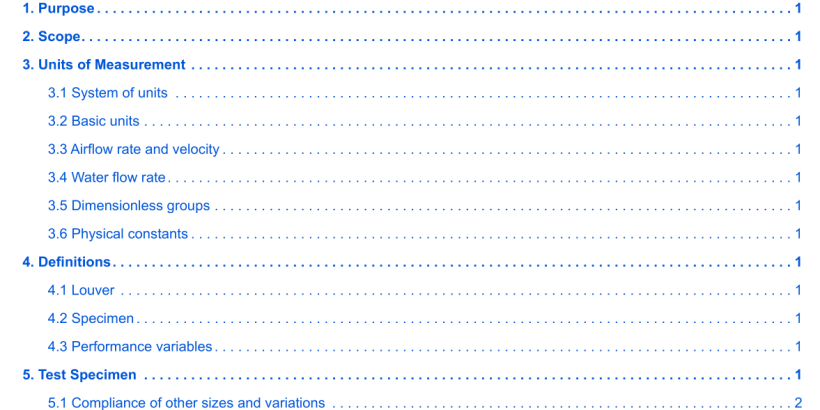ANSI AMCA 550-2015 pdf download.Test Method for High Velocity Wind Driven Rain Resistant Louvers
2. Scope
Tests conducted in accordance with the requirements of this standard are intended to demonstrate the acceptabil- ity of the louver in which water infltration must be kept to manageable amounts during a high velocity wind driven rain event. The test specimen can be approved in either an open or closed position as stated in Section 5.
3. Units of Measurement
3.1 System of units
SI units (The International System of Units, Le Systéme International d’Unités) are the primary units employed in this standard, with I-P units (inch-pound) given as the secondary reference. SI units are based on the fundamental values of the International Bureau of Weights and Measures, and I-P values are based on the values of the National Institute of Standards and Technology which are, in turn, based on the values of the International Bureau. 3.2 Basic units The SI unit of length is the meter (m) or millimeter (mm); the I-P unit of length is the foot (ft) or the inch (in.). The SI unit of mass is the kilogram (kg); the I-P unit of mass is the pound mass (lbm). The unit of time is either the minute (min) or the second (s). The SI unit of temperature is either the degree Celsius (°C) or kelvin (K); The I-P unit of tem- perature is either the degree Fahrenheit (°F) or the degree Rankine (°R).
3.4 Water fow rate
The SI unit of liquid volume is the liter (L); the I-P unit of liq- uid volume is the gallon (gal). The SI unit of liquid fow rate is the liter per second (L/s); the I-P unit is the gallon per min- ute (gpm).
3.5 Dimensionless groups
Various dimensionless quantities appear in the text. Any consistent system of units may be employed to evaluate these quantities unless a numerical factor is included, in which case units must be as specifed.
3.6 Physical constants
The density of distilled water at saturation pressure shall be taken as 998.278 kg/m 3 (62.3205 lbm/ft 3 ) at 20 °C (68 °F). The density of mercury at saturation pressure shall be taken at 13595.1 kg/m 3 (848.714 lbm/ft 3 ) at 0 °C (32°F). The spe- cifc weights in kg/m 3 (lbm/ft 3 ) of these fuids under standard gravity in a vacuum are numerically equal to their densities at corresponding temperatures.
5. Test Specimen
One 1000 mm x 1000 mm (39.37 in. x 39.37 in.) core area louver test specimen (as defned in ANSI/AMCA Standard 500-L) shall be submitted for this high velocity wind driv- en rain test. The same test specimen, or an identical test specimen, shall be tested in the full open position in accor- dance with the wind driven rain test detailed in ANSI/AMCA Standard 500-L and run at 22 m/s (50 mph) and 203.2 mm/ hr (8 in./hr) of rainfall. Operable louvers intended to be shut during a high velocity wind driven rain test can be closed for that test but must be open for the AMCA 500-L wind driven rain test. Louvers such as this will need to be clearly identi- fed on its test report, submittal and installation instructions for this qualifcation. Test specimens shall be as built, unpainted, clean, degreased and without additional factory-applied coating on the speci- mens’ surfaces that would enhance water shedding capabil- ity. All devices tested shall be without a screen across the air passages of the louver. The test specimen is any fxed, operable, or combination (fxed and operable) blade louver. The test specimen may also have the following devices attached directly or indirectly to the louver during testing and all are considered part of the test specimen: additional louver(s), damper(s), and sleeves. Sill pan(s)/fashing(s) may be used during testing and are considered part of the test specimen. All types of seals on items, such as blades, jambs, head/sill, blade stops, and caulking, are considered part of the test specimen, exclud- ing sealing between the test specimen and test wall.ANSI AMCA 550-2015 pdf download
